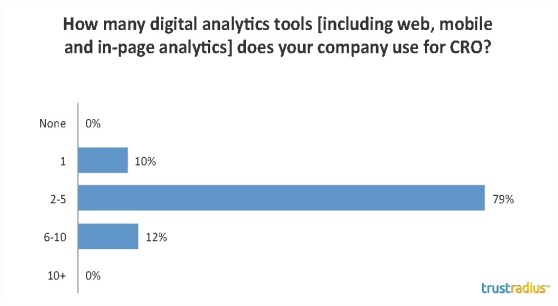Want smarter insights in your inbox? Sign up for our weekly newsletters to get only what matters to enterprise AI, data, and security leaders. Subscribe Now
A new survey from TrustRadius shows that conversion rate optimization software (CRO) is on the rise but that no one vendor is able to provide customers with all the tools they need.
“CRO is becoming more important as companies look for ways to improve their website’s effectiveness,” TrustRadius CEO Vinay Bhagat said in a statement. “Low-cost, easy-to-use tools have propelled a broader spectrum of companies to analyze website traffic and experiment with website changes. It’s therefore no surprise that companies of all sizes are increasingly investing in CRO software and skillsets.”
But the results of TrustRadius’ survey, which was conducted throughout July and August, show that organizations are using several tools for their CRO needs. In fact, the report paints a complex and fragmented picture.
91 percent of respondents are using two or more tools for digital analytics, including Google, KISSmetrics, CrazyEgg, and WebTrends. Nearly half of respondents said they are using two or more tools for A/B split testing, such as Optimizely, Unbounce, and SiteSpect.
Interestingly, while you might expect those that have more mature CRO processes to use fewer tools, the opposite is true. The longer a company has been working on CRO processes, the more software solutions it employs.
To help navigate the available software solutions, which include analytics and A/B split testing products, TrustRadius has announced a new Buyer’s Guide to Conversion Rate Optimization Software, downloadable from its website without charge.
The study also shows that CRO software spend is going to increase next year, a potential indicator that CRO solutions are seen as worthwhile and adding to the bottom line.
44 percent of the companies surveyed spend more than $10,000 annually for A/B split testing solutions, and 19 percent spend more than $50,000. Almost half of all respondents said they are going to spend more money on those tools in the coming year.
We’re studying mobile app analytics solutions.
Share your knowledge, and we’ll share all the data with you in return.
As we reported recently, analytics features are among the most popular additions to marketing automation suites. I wondered if this drive for analytics is helping to increase the popularity of CRO solutions or if it is the other way around.
“I think those features are actually the result of an increase in CRO interest,” Bhagat told me. “The bigger driver is the proliferation of low-cost and, in some cases, free tools in both A/B testing and analytics and an increasing realization that driving traffic is expensive, and therefore sub-optimal CRO is costly.”
So while the larger marketing suites get in on the analytics act, it is the smaller, more cost-effective tools that appear to be winning customers over.
With so many solutions in the CRO world and the lack of a clear winner in the space, what does Bhagat think the future will hold?
“In analytics, there’s a trend towards tracking behavior at an individual level in order to track customers across channels and devices, connecting analytics data to customer or even third-party information. All of this helps drive dynamic personalization of content, but that’s only among the most advanced,” Bhagat said.
CRO remains a more business to consumer–centric space at present, and Bhagat notes that retail, financial services, travel, and hospitality are the main verticals served. CRO may require a selection of disparate tools at present, but one thing is clear; organizations are benefiting from the process and expect to increase their investment in these tools going forward.



